McGowan — not McGown. Iconic Idaho peak in the Sawtooths has been misspelled for years
At 9,860 feet above sea level, McGowan Peak rises up majestically over Stanley Lake in the Sawtooth Range of Idaho.
It is one of the most iconic peaks in Idaho and is often referred to as the most photographed mountain in the Sawtooth National Recreation Area.

Wait a minute, Scott. You misspelled “McGowan.” It’s “McGown” Peak.
Or is it?
Most people certainly know the mountain as McGown Peak. It’s listed on signs, maps, guidebooks — even Google Earth — as McGown.
But it’s wrong.
McGowan Peak is named after George L. McGowan, who ran cattle in the Stanley Basin in the late 1800s and operated the McGowan Livestock Company and a general store in Challis.
“Named after George L. McGowan, who was among the first in the Stanley Basin Country,” according to a U.S. Geographic Board “decision card,” dated Feb. 21, 1916, entered by David Laing, forest supervisor.
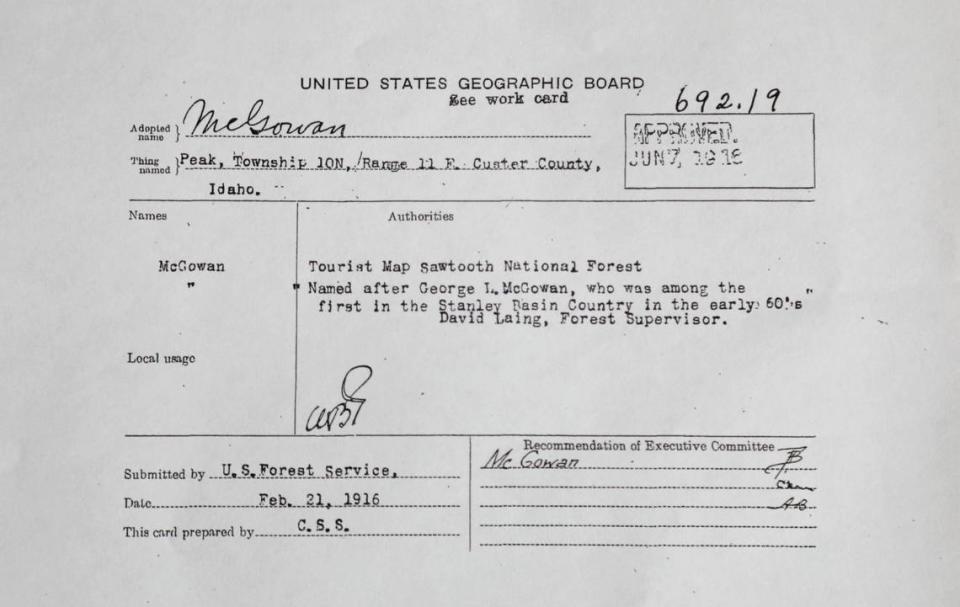
“It’s important to change the maps and fix the error,” George McGowan’s great-granddaughter, Augusta McGowan Hass, told me as we looked over historic documents on her kitchen table at her Meridian home. “They spelled it wrong, and they spelled it wrong forever. And it’s just wrong. The family would like it fixed.”
Tom McGowan, Augusta’s brother, still lives in Challis with his wife, Becky. He explained why it’s so important to the family.
“We know that George L. McGowan was a good businessman, an entrepreneur, very kind and giving, and people thought a lot of him,” Tom McGowan said Thursday in an interview at his sister’s house. “To us, we’re feeling that McGowan with an ‘a’ should stay, because we know it was named after him and it’s something we can pass down to our own heirs.”
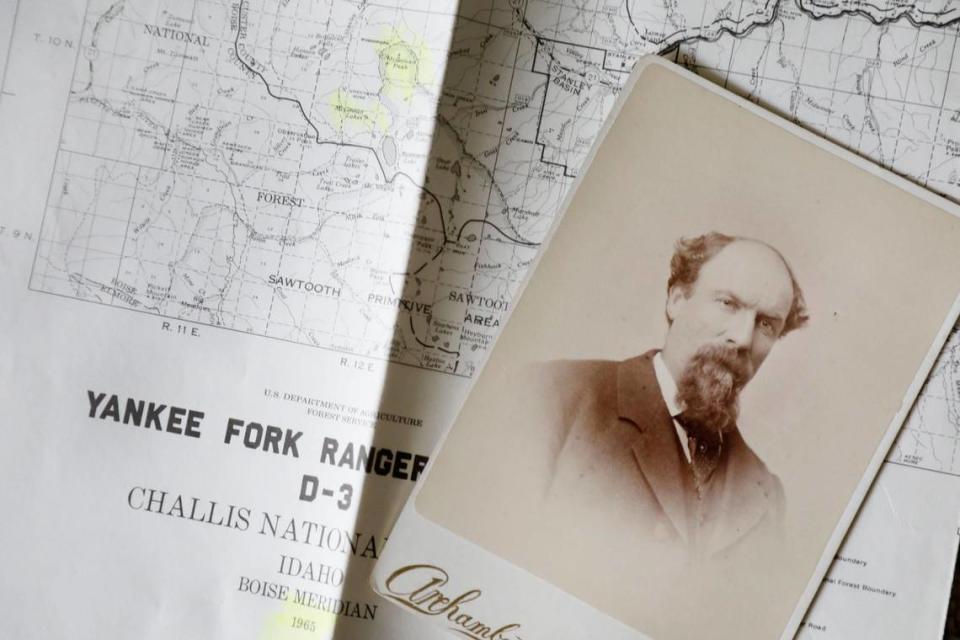
Initial mistake
The error appears to have originated in 1972, when a cartographer with the U.S. Geological Survey put “McGown Peak” on the map.
Guidebooks and blogs have it listed as McGown since. Maps from the U.S. Forest Service show McGown. Google maps and Google Earth show it as McGown. McGown Peak has a Wikipedia page with the misspelling. An internet search reveals dozens of posts on websites of guides, outfitters, climbers, outdoor enthusiasts, businesses and nonprofit organizations with the incorrect spelling.
There are very few posts with the correct spelling.
The U.S. Geological Survey had it listed as McGown for decades until apparently correcting it in 2013, a change that didn’t make it onto their maps until 2017.
The family contacted the office of U.S. Rep. Russ Fulcher, R-Idaho, to find out what happened. The USGS office confirmed to Fulcher’s office that the error did get caught in 2013 and fixed on the 2017 maps.
“It appears that in the early 1970s, an error was made on the USGS topographic map and the peak was mistakenly labeled McGown Peak,” according to a response from the USGS that Fulcher’s regional director Dirk Mendive forwarded to McGowan Hass. “There is no explanation ... as to the reason for the change … so we can only assume it was a typographical error.”
One family, two spellings
But there is a clue as to why it might have changed.
George McGowan had a brother who went by the name Arthur McGown Sr. Why he dropped the letter “a,” no one knows, according to the family.
There’s speculation about whether their ancestors from Canada spelled it with an “a” or without it. Whatever the reason, George L. McGowan spelled it McGowan, and his brother spelled it McGown.
Both sides of the family maintained a long lineage in Custer County.
George McGowan’s family stayed in Custer County, and the historical record — and the town of Challis and Custer County, itself — is filled with references to the McGowan family and George McGowan’s descendants.
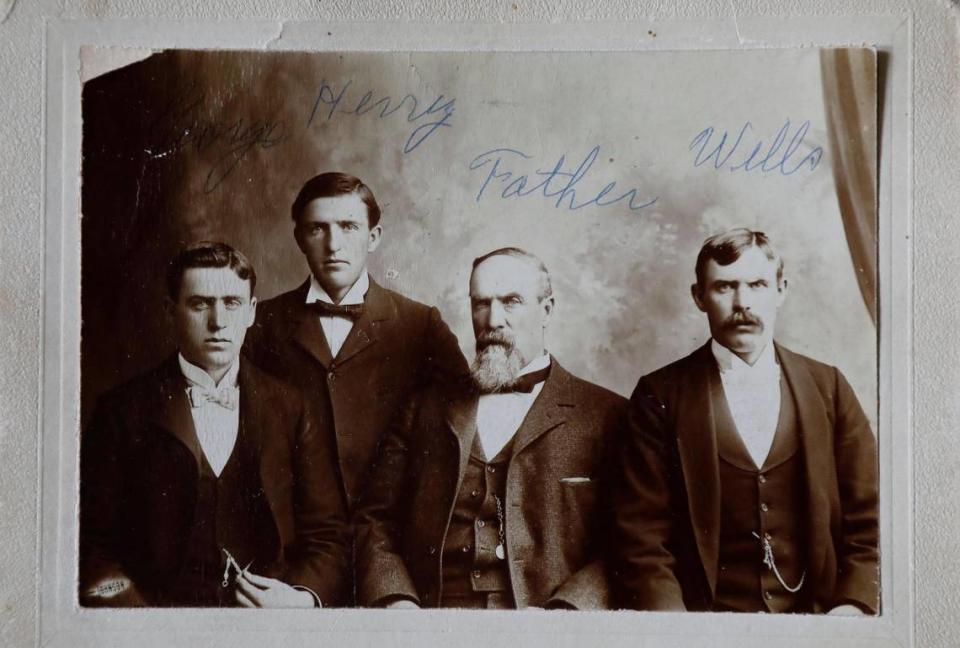
After George McGowan died in 1903, his heirs formed the Geo. McGowan Company. His widow, Lavantia, worked in the store, while sons George, Henry and Wells operated the Challis Ranch, Stanley Ranch, and property in Bonanza. Son Verne Ambrose, after going off to business college in Salt Lake City, came back to work in the store. Verne Ambrose later became county assessor and ran the state liquor store in town.
Verne Ambrose’s son, Verne Angus “Gus” McGowan, was the local dentist for 40 years, served on the Challis City Council and eventually became mayor of Challis.
Gus McGowan’s son, Tom McGowan, is still in Challis, where he took over the family practice, from which he retired in February. He’s served on the school board and with the Lions Club and coached boys and girls basketball. His siblings, Bill, Augusta and Jim, have since moved on from Challis to California, Meridian and Montana.
But the McGowan name in Custer County continues today. Tom McGowan’s son Calvin runs McGowan Outfitting, a hunting and fishing outfitter in Challis, and Tom McGowan’s other son Bryan is an accountant at Thompson Creek mine. Bryan has a son, and Calvin has two daughters, all carrying on the McGowan name.
But Arthur McGown Sr. also had family who stayed in Custer County.
Arthur McGown Sr.’s son, A.W. “Tuff” McGown, and his wife, Edna McGown, also were prominent members of the community. In 1961, they established the Custer Museum, which they later sold to the U.S. Forest Service for $12,000 in 1966.
Edna McGown, who received an Esto Perpetua award for her contributions to Idaho history, was a collaborator and the source of historical facts used in oft-cited books, “Stanley-Sawtooth Country” and “The Land of the Yankee Fork,” both by Esther Yarber.
“Land of the Yankee Fork” was published in 1963. Throughout the entire book, McGown is spelled without the “a,” even in references to George L. McGowan and his family.
Interestingly, in the follow-up book, “Stanley-Sawtooth Country,” published in 1976, McGowan is spelled correctly when referring to George L. McGowan and his family.
But by that time, the USGS map had been changed to “McGown,” where it remained misspelled for the next 41 years, spawning a raft of misspellings.
“It was a miscarriage of justice is what it was,” Bill McGowan — Augusta McGowan Hass and Tom McGowan’s brother — said by phone. “We were getting flimflammed.”
Bill McGowan, who now lives in California, thinks that somewhere along the line, the McGown side of the family convinced the Forest Service to rename the peak after Art McGown, or otherwise convinced the Forest Service that McGowan was a misspelling.
It has bothered the family ever since it started popping up on maps and elsewhere in the 1970s.
Historical research
Tom McGowan’s wife, Becky, has spent several years researching the name and trying to settle the matter once and for all. The internet and the growth of digitized historical records have made research easier.
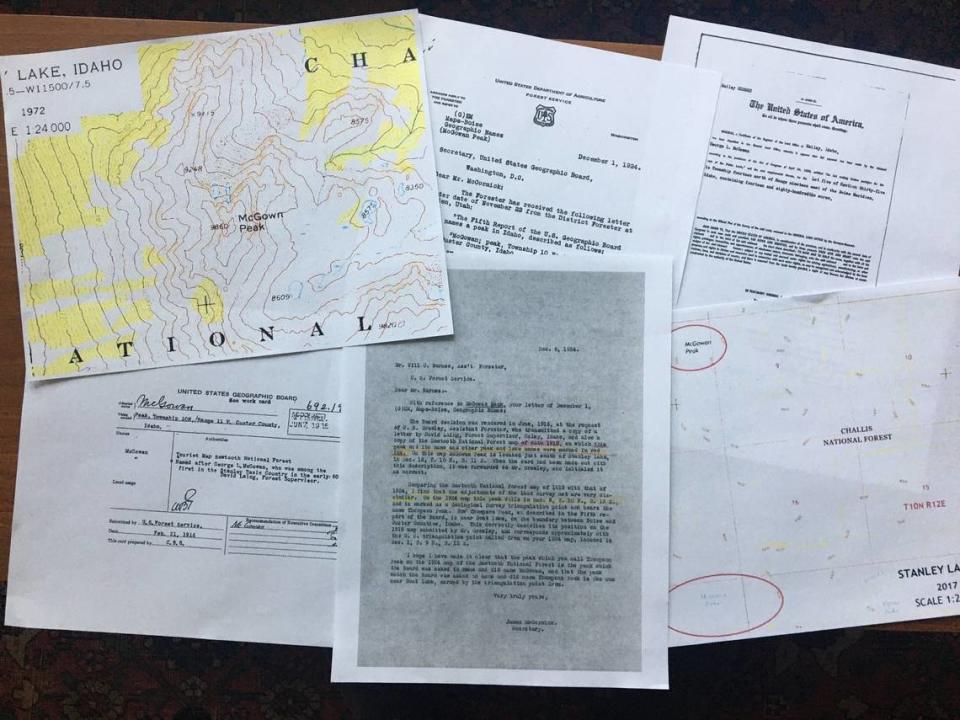
She provided me with a stack of documents establishing the McGowan family in the Stanley Basin and George L. McGowan’s prominence in the area. It includes newspaper articles, government records, letters between government officials and citations from numerous books — chief among them, “Idaho Place Names,” by Lalia Boone, which correctly spells McGowan throughout.
Becky McGowan was also able to locate a 1965 map of the Challis National Forest’s Yankee Fork Ranger District showing McGowan Peak spelled correctly. Not only that, nearby McGowan Lakes and McGowan Creek are spelled with the “a.”
She hasn’t been able to find the origin of McGowan Lakes and McGowan Creek, but it stands to reason they are also named after George L. McGowan.
Dick d’Easum, in his 1977 book “Sawtooth Tales,” noted the controversy of the name.
“The mountain dominating Stanley Lake is designated on most maps as McGown Peak,” d’Easum writes. “Controversy breaks out right there. … If the peak is named for Arthur McGown, Sr., ... McGown is right. On the other hand, it may honor George McGowan, an early county commissioner who mined and ranched on Valley Creek.”
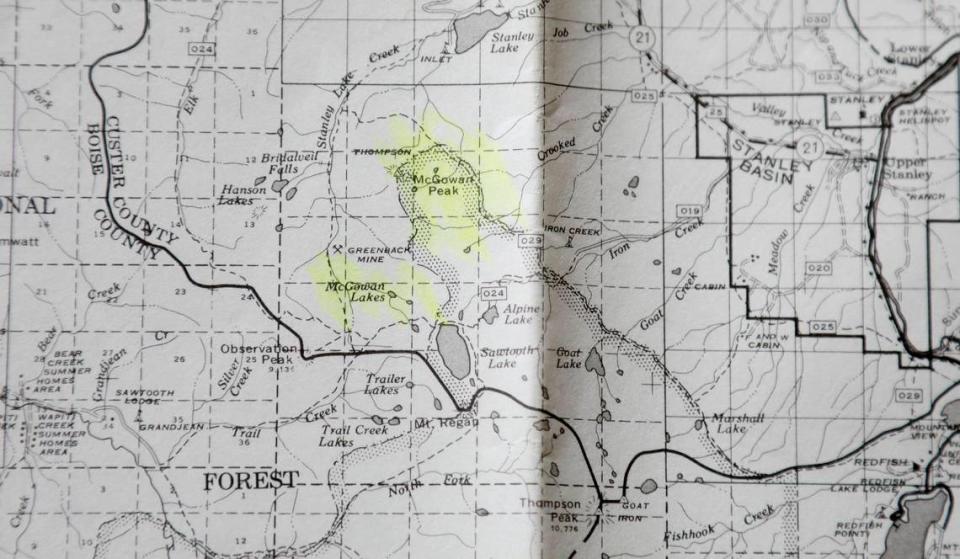
One other key piece of evidence Becky McGowan was able to track down: She found a request to name another peak Pinchot after someone who was still alive. The U.S. Forest Service at the time declined to name the peak after Pinchot “because it is in conflict with the rule of the Board against naming features for living persons,” according to the letter, dated May 10, 1916, from W.B. Greeley, assistant forester for the U.S. Forest Service, to C.S. Sloane, secretary of the U.S. Geographic Board. (That letter also gives approval to name McGowan Peak as such.)
George L. McGowan died in 1903. Arthur McGown Sr., who died in 1938, was still alive when the peak was named in 1916.
But the main definitive evidence remains the card from the U.S. Geographic Board that clearly states the peak is named for George L. McGowan.
Who was George L. McGowan?
“We shall not err in rating Mr. McGowan as a great man,” according to the news item of George L. McGowan’s death in the Challis Silver Messenger in 1903. “The goodness which inspired him, the judgment which guided him, the courage which animated him, the faithfulness which characterized him, surely these and other elements of modest quality were so blended in him as to make him great.”
McGowan was born May 1, 1840, near Montreal. When he was 17, he lit out for the United States, first to St. Louis, then to Nevada, California, British Columbia, Montana, Wyoming and eventually Utah, where he met and married his first wife. They moved back to Montana, where they had three sons, and she subsequently died.
That’s when he moved to Bonanza, in Custer County, in 1879 to run a butcher business. He expanded to ranching, running at least 2,500 head of cattle in the Stanley Basin, according to historical records. He also was a stockman and ran a mercantile business in Challis. At one point, he ran the “largest shop in Pocatello,” according to one newspaper account.
He later married his late wife’s sister and had two more children.
He served as Custer County commissioner for two terms.
“His life was an open book — he was generous to a fault; his home was a welcome shelter for his friends as well as his camp on the range,” according to the Silver Messenger, which devoted two columns of news space to his obituary. “He was never known to turn those in distress from his door. His heart was as tender as a child’s. Those who knew him best loved him most.”
He died Sept. 3, 1903, of stomach cancer. When word reached Challis of McGowan’s illness, the local paper noted the sad news.
“This is sad news, indeed, for he is one of Custer County’s very best men,” wrote the Silver Messenger on June 16, 1903.
Setting the record straight
The misspelling of McGown is now everywhere, and it likely will take years — if not decades — to get the record completely fixed, because the wrong name has been accepted as the correct spelling for so long.
Since it’s been fixed officially with the USGS, it now just has to catch on and spread via word of mouth — like this column.
I reached out to the Sawtooth National Forest. Their maps show McGown Peak. I haven’t heard back yet.
The McGowans said they’ve contacted the Sawtooth National Recreation Area cartographers and were told that they would fix the maps the next time there’s a printing. But the McGowans are skeptical.

When I hiked to Sawtooth Lake last weekend, I stopped by the Stanley Lake campground, where a carved wooden sign had the misspelling. That needs to get fixed.
Gary Gadwa, past president of the Sawtooth Interpretive and Historical Association, said he’s been in contact with the McGowan family numerous times over the years, and he is in complete agreement with them.
Rick Just, who is chairman of the Idaho Geographic Names Advisory Board, said he was not aware of a request to correct the name. His board meets about once a year to review what he said are a handful of requests from the U.S. Geographical Names Board. Everything goes through there first, and then comes to the Idaho board for a recommendation, which then goes to the Idaho State Historical Society Board.
Once approved there, it’s passed back to the U.S. Geographical Names Board, Just explained via an email. Since it’s been corrected on the official USGS topographical map, there’s not much more for the Idaho advisory board to do.
That leaves all the other untold websites, blogs, guidebooks, interpretive signs and other references that need to be corrected.
Hopefully this column is a start, and once and for all, George L. McGowan will get his due.
Scott McIntosh is the opinion editor of the Idaho Statesman. You can email him at smcintosh@idahostatesman.com or call him at 208-377-6202. Follow him on Twitter @ScottMcIntosh12.

